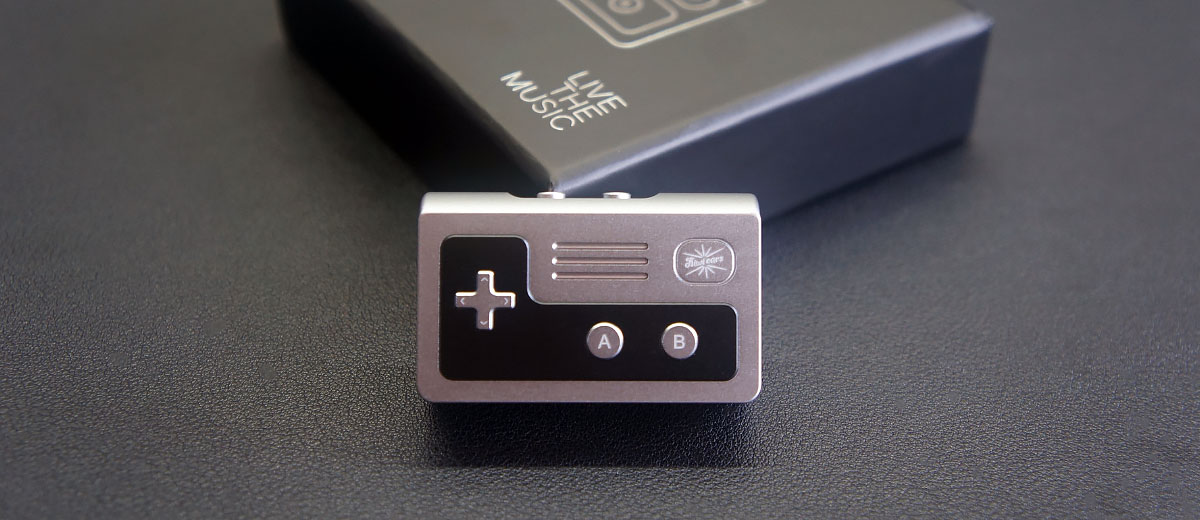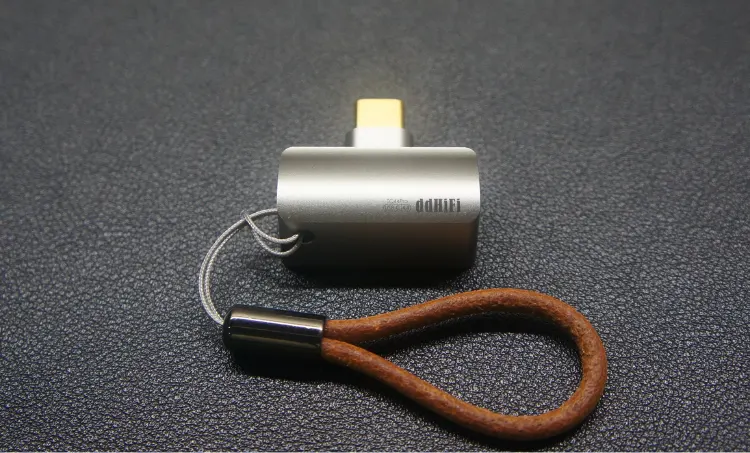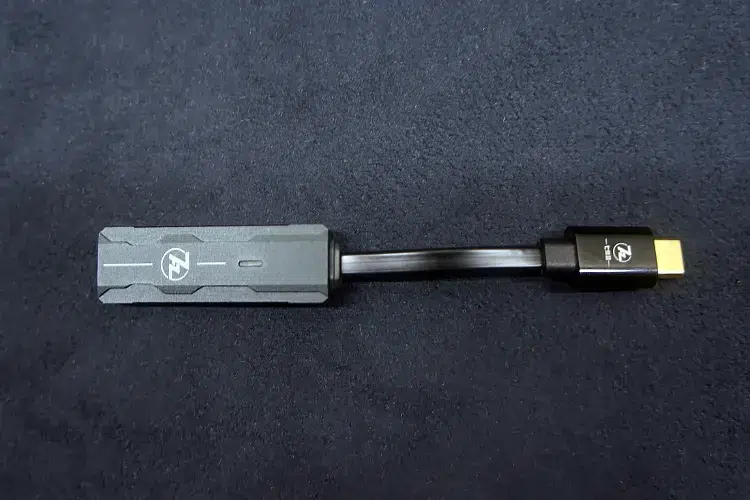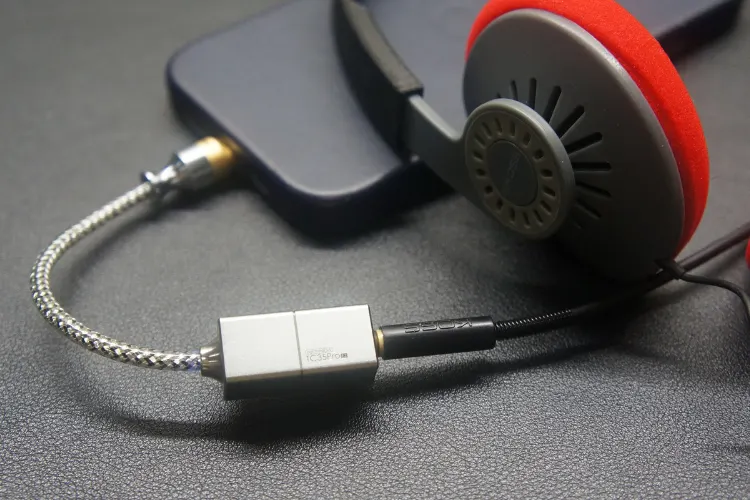Select Comparisons
ddHiFi TC44Pro
Technical
The TC44Pro uses dual Cirrus Logic CS43131 DAC Chips, enabling it to decode up to PCM 32BIT/384kHz and DSD256. The Allegro has the same decoding capabilities, albeit with a Sabre ES9028Q2M chip instead.
The TC44Pro has its sole input attached to the main PCB and body without any cables, while the Allegro uses a detachable USB-C cable through its USB-C female input, letting the listener use any cable compatible with their source device.
The TC44Pro comes with either Lightning or USB-C inputs and has a 4.4mm BAL jack as its sole output, whilst the Allegro has both 3.5mm SE and 4.4mm BAL outputs.
Through this balanced out, the TC44Pro can output up to 120mW@32Ω, whilst the Allegro can output up to 155mW@32Ω and 70mW @32 Ω through its SE output.
Design
Both dongles have different form factors, but share a common CNC-machined aluminum construction, so each offers a premium finish.
The original TC44Pro packs all its USB-C input and 4.4mm BAL output inside one metal body without any cables sticking out.
It’s light at just 9g and small, with measurements of 30x18x12.5mm, making it much smaller and lighter than the Allegro which comes in at approximately 45×28 x13mm.
The Allegro’s design is immediately more attention-grabbing than the TC44Pro, with an aluminum shell designed to imitate the shape and layout of classic console controllers.
Performance
The tonality and sound signature of the TC44Pro and the Kiwi Ears Allegro have some clear differences, with the TC44Pro opting for a more neutral sound signature with good technicalities.
The bass on the TC44Pro has better resolution and texture. The microdetail in the decay of each percussive instrument was better translated when feeding the signal from the TC44Pro.
The Allegro edges out the TC44Pro in note weight and warmth. The same drum hits are less textured but are played back with more physicality.
I found that neither dongle’s bass bled into the mid-range, though the Kiwi Ears Allegro bass had a warmer presentation.
As a result, I found that string instruments in the mid-range had a more natural-sounding tonality from the TC44Pro. Without any peaks in the upper mids and lower treble, the TC44Pro did not exhibit a metallic-sounding tonality that the Allegro had with select instruments.
Vocals were more resolving when played back through the TC44Pro. However, I found that deeper male vocals were presented with more authority and weight from the Allegro.
The treble region of the TC44Pro was less sibilant and less harsh than that of the Kiwi Ears Allegro. For extended listening periods, I found myself gravitating towards the TC44Pro since it was the least fatiguing dongle.
The TC44Pro was superior in both staging and imaging. The TC44Pro’s imaging was pinpoint, making individual sounds easily identifiable even in complicated mixes. The TC44Pro also has improved vertical staging.
7hz SEVENHERTZ 71
Technical
The Allegro uses a Sabre ES9028Q2M DAC chip, whereas the SEVENHERTZ 71 opts for an AKM AK4377 DAC chip.
Both dongles are capable of decoding up to PCM 32BIT/384kHz, however, the 71 has lower natiev DSD capability at DSD128.
The 71 dongle’s sole input is the USB-C male termination at the end of the unit’s attached cable, while its only output is a 3.5mm SE output.
The Allegro is more comprehensive in comparison, making use of a detachable USB-C to USB-C cable that can easily be swapped out to connect to lightning or USB-A devices. The Allegro has more robust output options as well, integrating both 3.5mm SE and 4.4mm BAL outputs.
The Allegro can output up to 155mW@32Ω through its balanced 4.4mm output, and 70mW @32 Ω through its 3.5mm SE output, while the 71 can power up to 70mW into the same @32 Ω single-ended only.
Design
The 71’s main body is constructed from lightweight anodized black aluminum with geometric edges breaking an otherwise basic silhouette. It is also much smaller in size compared to the Allegro.
The Allegro’s larger size and surface area also house more visual flare and creative design choices. Adopting a retro console-themed design makes it less stealthy and minimalistic.
In on-the-go usage, the 71 feels like an extension of the IEM cable, whereas the Allegro feels like its own device that needs to be nestled right behind the source device.
Performance
The 7hz 71 had a significantly darker presentation than the already warm Kiwi Ears Allegro, with more body to low-end notes.
Bass hits from kick drums had stronger impact and emphasis through the 71, however, they were not as resolving or textured as the Allegro’s bass response.
The Allegro was able to play back the decaying tones of drums and synths with a stronger sense of fidelity, highlighting nuanced changes in the tones. The bass coming from the 71 did tend to bleed into the mids, contributing to a more veiled overall presentation.
In terms of midrange emphasis and resolution, the Allegro was in a league of its own when compared to the 71. String instruments in particular highlighted this, with each pluck and strum sounding more natural with better resolution and note weight.
Female vocals were another stand-out when comparing the Allegro against the 71. The more natural presentation of the Allegro translated to better vocal clarity, highlighting the emotion in the vocalist’s voice.
The 71 and its darker signature had less energetic and airy treble when compared to the Allegro, however, this also meant that it did not exhibit the same harshness that the Allegro had in the upper mid to lower treble range.
Despite being less technically proficient in the treble range, I found myself gravitating to the 71 more, simply because it was less fatiguing to listen to, especially in extended listening sessions.
ddHiFi TC35Pro Eye 2
Technical
The TC35Pro uses a Cirrus Logic CS43131 DAC chip, while the Allegro has a Sabre ES9028Q2M DAC chip.
However, both dongles have identical decoding capabilities, capable of decoding up to PCM 32BIT/384kHz and up to DSD256.
The TC35Pro Eye 2 comes with an attached Lightning connector or an attached USB-C male termination, with both versions having a single 3.5mm SE jack as their sole output.
The Allegro’s superior versatility carries in its outputs wherein it sports both a 3.5mm SE jack and a 4.4mm BAL jack.
Through its balanced output, the Allegro can deliver up to 155mW @32Ω, and 70mW @32Ω, while the less powerful TC35Pro 2 can only drive up to 65+65mW @32Ω.
Design
The TC35Pro E2 is made of silver-colored aluminum in the shape of a rectangular prism and is smaller than the Allegro, which has a bigger, game-controller-inspired design.
The ddHiFi dongle is discreet and feels like part of the IEM cable, whereas the Allegro is bulkier and needs to be placed near the device in on-the-go usage.
Performance
Compared to the Allegro, the TC35Pro is a better-resolving dongle with a more neutral tonality across the frequency response.
When comparing the two dongles, the TC35Pro Eye 2 stands out for its enhanced bass resolution and texture, capturing microdetails in the hits and decay of drums and other percussive instruments. While the Allegro excels more when comparing note weight and ability to present bass in a more textured manner.
Both dongles maintain clean bass-to-mid-range transitions, with the Allegro offering a warmer sound overall. The TC35Pro Eye 2 delivers a more natural tonality for mid-range string instruments, avoiding metallic tones that presented themselves in the upper-mids region of the Allegro.
Vocal reproduction is detailed on both, with the TC35Pro Eye 2 highlighting vocal nuances more effectively. The Allegro presents deeper male vocals with more weight.
The TC35Pro Eye 2 offers a smoother, less fatiguing treble presentation. It also exhibited some sibilance but not to the same degree as the Allegro.
My Verdict
The Kiwi Ears Allegro is a uniquely designed and well-built dongle DAC with a versatile set of input and output options.
Its unique combination of low-end warmth and sharp sibilance in the upper treble means that finding a good pair of IEMs to pair with it is essential for an enjoyable listening experience.
With respectable power output on both its 3.5mm SE and 4.4mm BAL jacks, it has enough on-paper specifications to cater to budget and mid-fi IEMs through multiple upgrades. However, I found its harshness in the upper-mids to a lower-treble region better for smoother-sounding IEMs.
With its unique visual flair and sound signature, the Allegro is certainly not for everyone. But if its design and sonic choices do match your needs and preferences, it provides a good value with its versatility.
Kiwi Ears Allegro Technical Specifications
- DAC Chips: Sabre ES9028Q2M DAC
- Output(s): 3.5mm Single Ended and 4.4mm Balanced
- THD+N <0.0015% @1kHz
- Output Power: 70mW @32 Ohms (SE) and 155mW@32 Ohms (BAL)





